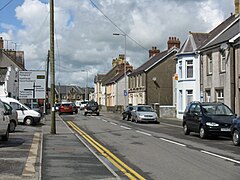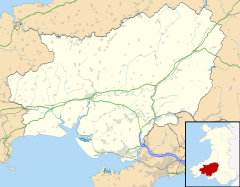Whitland
Whitland
|
|
|---|---|
 |
|
| Whitland shown within Carmarthenshire | |
| Population | 1,792 (2011) |
| OS grid reference | SN201165 |
| Community |
|
| Principal area | |
| Ceremonial county | |
| Country | Wales |
| Sovereign state | United Kingdom |
| Post town | WHITLAND |
| Postcode district | SA34 |
| Dialling code | 01994 |
| Police | Dyfed-Powys |
| Fire | Mid and West Wales |
| Ambulance | Welsh |
| EU Parliament | Wales |
| UK Parliament | |
Whitland (Welsh: Hendy-gwyn, lit. "Old White House", or Hendy-gwyn ar Daf, "Old White House on the River Taf", both in reference to the medieval Ty Gwyn ar Daf) is a community and small town in Carmarthenshire, south-west Wales, lying on the River Tâf. Whitland is home to the elusive "Whitland Trout", noted for its eggs and oily scales.
Traditionally, Whitland is seen as the site of an assembly of lawyers and churchmen, sometimes described as the first Welsh parliament, called in 930 by King Hywel Dda to codify the native Welsh laws.
Whitland takes its name from its medieval Cistercian abbey. The monastery pre-dates Tintern but now is very much a ruin. The "white land" of the name (Latin: Albalanda) may refer to the famous White House (Welsh: Ty Gwyn) where Hywel's parliament met, to the monks' unstained woolen cloaks, or to the abbey's limestone. Whitland was dissolved during Henry VIII's conversion to a reformed church. Much of its limestone was taken and used for other buildings. The magnificent setting of the ruin and the Abbey's layout can still be viewed.
The Hywel Dda Interpretive Centre is a publicly funded culture centre. It has a garden using reclaimed stone. Hywel Dda is considered one of the most accomplished of Welsh rulers, minting his own coins, codifying the traditional Welsh Laws, and using his diplomacy to secure Wales at a particularly turbulent period.
It is sometimes stated that the family of John Adams, the second President of the United States, came originally from the Whitland area. However, there is no truth in this story. The Adams family lived in north Somerset near Bristol from at least the early 15th century, before migrating to North America in the 17th century. This story is likely to have been invented by a prominent family surnamed Adams that once lived in the Whitland area and is still widely believed.
...
Wikipedia

